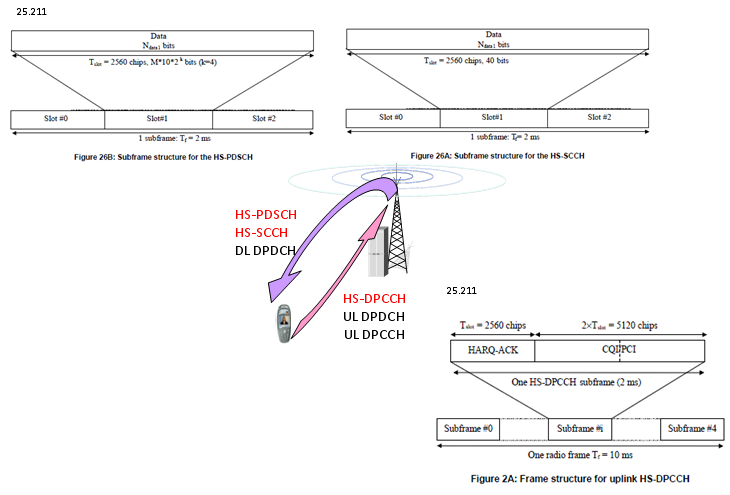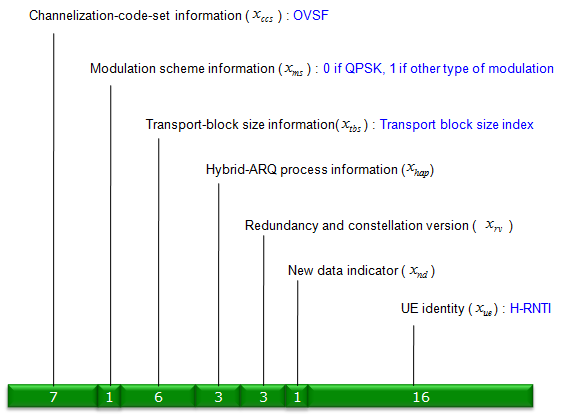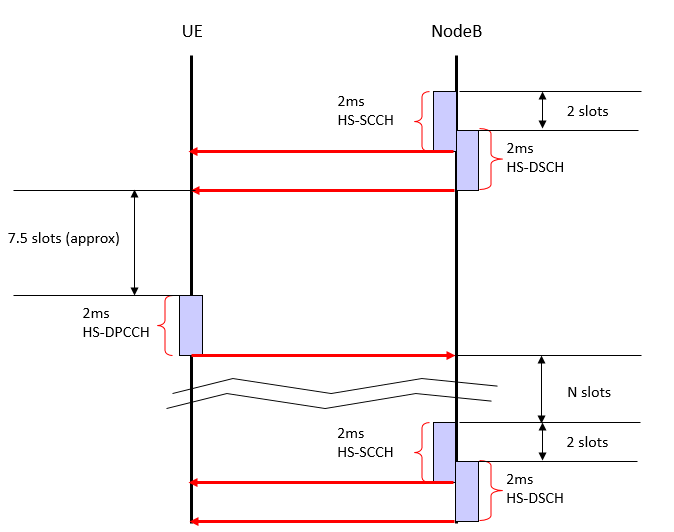|
3G/UMTS |
||
|
Physical Layer - HSDPA
Following is physical channel make-up for HSDPA network.
In HSDPA, three four new physical channels were introduced
i) HS-DSCH ii) HS-SCCH iii) HS-DPCCH iv) F-DPCH
With introduction of these four channels, we could implement many of the methods to improve the data rate which has been briefly descrived in previous section.
The most important channel is definately HS-DSCH (High Speed Downlink Shared Channel). As the name implies, it is a SHARED channel whereas in R99 we used a DEDICATED channel. It means all the users within a cell is sharing a single channel which is a big pipes rather than each of the users has it's own dedicated channel which is a small pipes. With this the network can optimize the resource allocation among the multi users more efficiently. For example as an extreme case the network allocate 91% of resources to a single UE and only 1% of resources to each of the remaining 9 users when the nine user does not require much resource or those 9 users are in such a poor environment where it can utilize only small fraction of the transmission capacity. In case of using dedicated channel, we cannot do this kind of extreme resource allocation because each of the dedicated channels requires a certain level of minum resource allocation even when the real utilization is lower than the minimum resource allocation.
I said HS-DSCH is a shared channel. It means that the whole data in the channel is recieved by all users. Then how can a UE figure out whether the data is for that UE or for some other UEs. I also said in HSDPA multiple modulation scheme is used, QAM and 16 QAM. Then how can a UE knows whether the data is QAM modulated or 16 QAM modulated ? To carry all these information, another new channel was introduced and it is HS-CCCH (High Speed Common Control Channel). The information carried by HS-CCCH is as follows : i) Transport format information - code tree for the data, modulation scheme, transport blocksize ii) Hybrid-ARQ related information
I said at the beginning, HSDPA uses a shared channel and try to achieve the optimum resource allocation at multi user level. To do this, the network should know the exact status of the UE. And the network should know whether the data it sent successfully reached it's destination (a specific UE). To enable this, UE reports its communication quality and the data reception status to the network repeatedly. For UE to send this information to network, it uses a special channel called HS-DPCCH. This channel carries CQI (Communication Quality Indicator) and Ack/Nak info.
So far so good. It seems there is only advantages of introducing these new channels, but there is nothing that gains 100% without losing anything. There is a drawback of relying on these shared channel method. It is about power control issue. You know that one of the critical requirement of WCDMA technology is a very sophisticated power control. If UE power is too low, Node B would have difficulties decoding it and if the power is too strong it can act as a noise to other UEs communicating with the Node B. For this purpose, Node B sends a UE a power control message periodically and this message should be different for all the UE because each UE may be in a different channel condition, meaning this power control message should be a "Dedicated" message. But as I explained HS-DSCH is a shared channel. Then how can Node B deliver the power control message for each specific UE. The solution was to use R99 dedicated channel (DPCH) carrying only the power control message. But using a full DPCH only for carrying a small power control message is waste of resource. To improve this situation, from Release 6 a new channel was introduced and it is F-DPCH (Fractional DPCH). The details of F-DPCH is out of the scope of this section and I wouldn't explain any further on this channel.
HS-SCCH is the downlink control channel which carries the information for downlink data channel (HS-DSCH). If you are more familiar with LTE and study backward to UMTS, think of HS-SCCH as a DCI in LTE PDCCH. As you have several different types of DCIs in LTE, there are a couple of different types of HS-SCCH in HSDPA.
HS-SCCH Type 1 which is normally used for HSDPA in non-MIMO configuration has structure as shown below (See 25.212 4.6 Coding for HS-SCCH type 1 for details)
Physical Layer Data Transaction
HARQ Memory Partitioning
Total number of soft channel bits in HS-DSCH defines the maximum number of soft channel bits over all HARQ processes. When explicit signalling is used, UTRAN configures Process Memory Size for each HARQ process so that the following criterion must be fulfilled in the configuration:
Total number of soft channel bits in HS-DSCH ≥ sum of Process Memory Size of all the HARQ processes.
Example > Take case of Cat 14 Case 1 : 259200/6=43200. And, the assignable value of 43200 is 40000.
memoryPartitioning explicit |+explicit 6 | + HARQMemorySize hms40000 | + HARQMemorySize hms40000 | + HARQMemorySize hms40000 | + HARQMemorySize hms40000 | + HARQMemorySize hms40000 | + HARQMemorySize hms40000
Other assignable value around this are 36000 / 40000 / 44000. And, HARQMemorySize value is less than 43200.
NOTE : In this case, you have to be carefull in designing TFRI table. You have to make it sure that TBS for a TFRI does not exceed the 4000 bits.
Case 2 :
Other assignable value around this are 30200 / 32000 / 36000.
harqinfo |++numberOfProcesses 8 <=== Set the number of HARQ value. |++ memoryPartitioning explicit | |++ explicit 8 | | |++ HARQMemorySize hms32000 | | |++ HARQMemorySize hms32000 | | |++ HARQMemorySize hms32000 | | |++ HARQMemorySize hms32000 | | |++ HARQMemorySize hms32000 | | |++ HARQMemorySize hms32000 | | |++ HARQMemorySize hms32000 | | |++ HARQMemorySize hms32000
|
||


